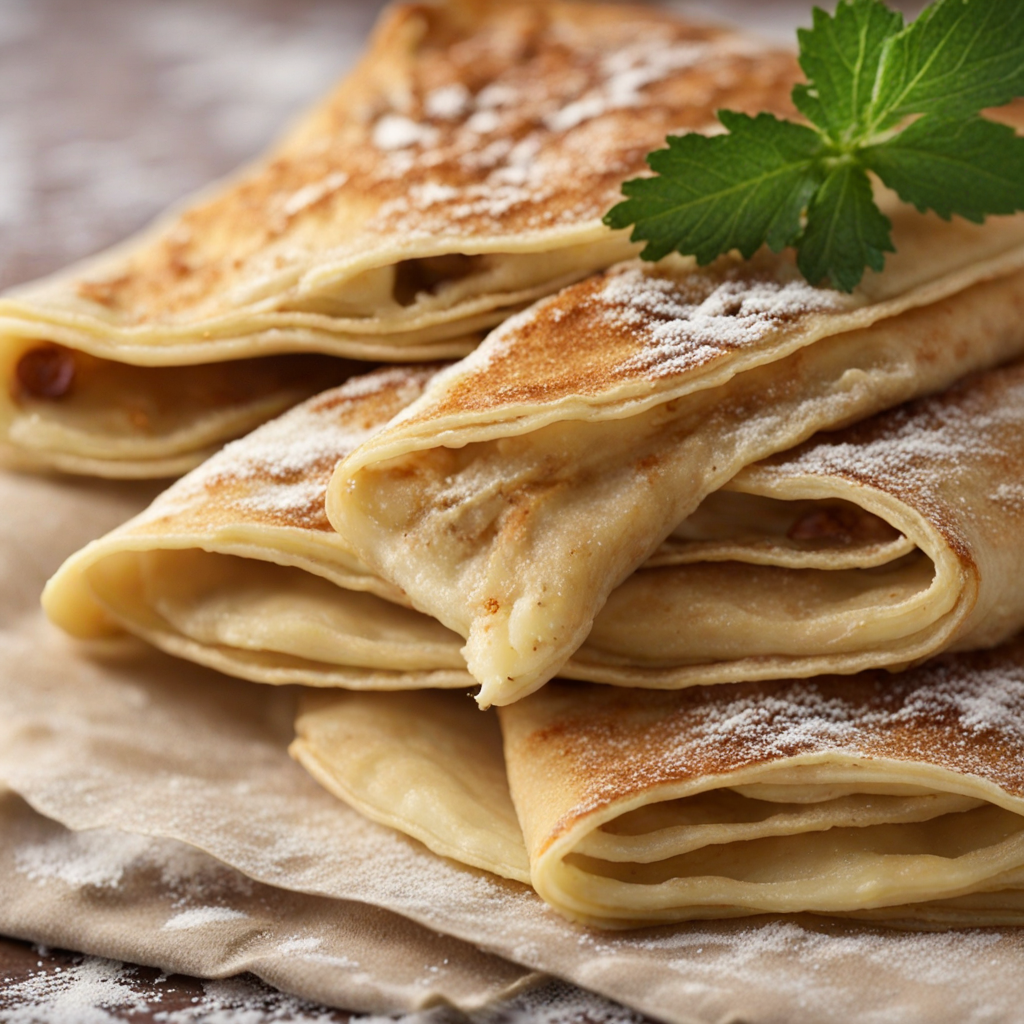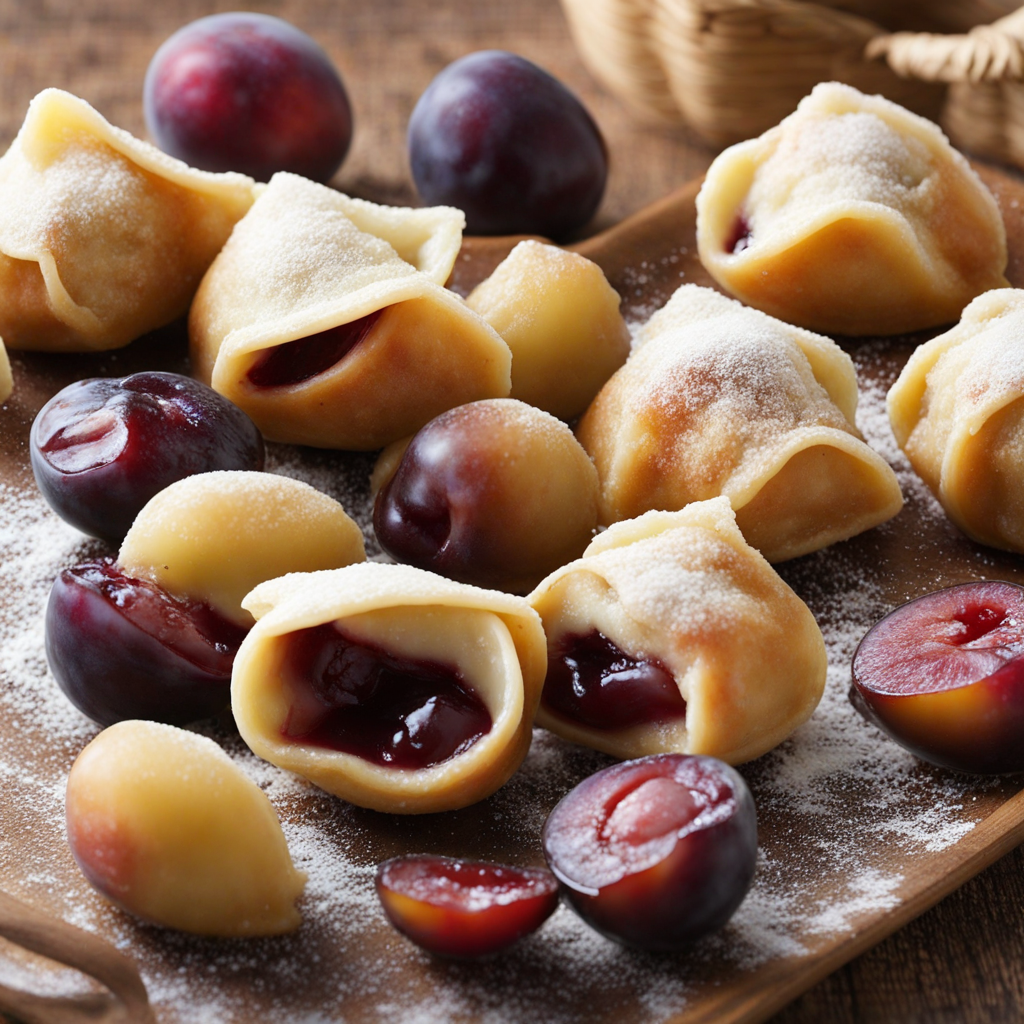Naleśniki
Naleśniki are a delightful Polish dish that can be likened to crepes but come with their own unique flair. These thin pancakes are made from a simple batter of flour, eggs, milk, and a pinch of salt, which is cooked until golden brown. Their delicate texture provides the perfect canvas for a variety of fillings, making them a versatile dish that can be enjoyed at any time of day. Whether you prefer sweet or savory, naleśniki can satisfy your cravings with their adaptability and comforting nature. Traditionally, sweet naleśniki are filled with a luscious mixture of sweetened cheese, often ricotta or twaróg, and are sometimes enhanced with vanilla and fruit preserves. They are typically rolled or folded and served dusted with powdered sugar or drizzled with chocolate sauce. On the other hand, savory versions might include fillings like sautéed mushrooms, spinach, or minced meat, often topped with a creamy sauce or served alongside a fresh salad. This duality of flavors makes naleśniki a beloved choice for both breakfast and dinner across Poland. The experience of enjoying naleśniki goes beyond just taste; it’s about the warmth of Polish hospitality. Often, they are served at family gatherings or festive occasions, highlighting their role in Polish culture. Each bite is a blend of nostalgia and comfort, inviting you to savor the moment. As you explore this dish, you’ll find that naleśniki not only offer a taste of Poland but also a glimpse into the heart of its culinary traditions.
How It Became This Dish
Naleśniki: A Culinary Journey Through Polish History Naleśniki, the delightful Polish crepes, are a beloved staple of Polish cuisine that embodies rich cultural traditions and historical influences. These thin, delicate pancakes have been enjoyed for centuries and have become a symbol of comfort and home-cooked meals in Poland. To truly appreciate naleśniki, one must explore their origins, cultural significance, and the evolution of this beloved dish over time. #### Origins in Ancient Traditions The concept of a flat, round bread-like food can be traced back to ancient civilizations. While it is difficult to pinpoint the exact moment when naleśniki emerged, the tradition of making pancakes is centuries old and has roots in various cultures across Europe. In Poland, the earliest references to pancakes date back to the 15th century, when they were made with rye or barley flour and served with various fillings. These early pancakes were less refined than modern naleśniki and were often thicker and heartier, reflecting the agricultural lifestyle of the time. As the Polish diet evolved, so did the recipes for these pancakes. The introduction of new ingredients, such as wheat flour, became popular as trade routes expanded and agricultural practices improved. #### Cultural Significance Naleśniki have deep cultural significance in Poland, often associated with family gatherings, celebrations, and traditional holidays. They are commonly served during special occasions such as Maslenitsa (a pre-Lenten festival) and Fat Thursday, where the act of making and eating pancakes symbolizes the celebration of abundance and the farewell to winter. In Polish households, naleśniki are often filled with a variety of ingredients, both savory and sweet. Common fillings include sweet cheese, fruits like strawberries and blueberries, and savory options like mushrooms, sauerkraut, or meat. The versatility of naleśniki allows for creativity and personalization, making them a favorite not only among families but also among chefs who seek to showcase Polish culinary traditions. #### The Role of Naleśniki in Polish Cuisine Naleśniki can be seen as a canvas for culinary creativity, allowing for a wide range of fillings and toppings that reflect regional ingredients and flavors. In the northern regions of Poland, for example, naleśniki might be filled with fresh berries or sweetened cottage cheese, while in the south, hearty fillings like potato and cheese or meat are more common. This regional variation highlights the diversity of Polish cuisine, shaped by geography, climate, and local agricultural practices. Moreover, naleśniki have been a part of Polish hospitality, often serving as a dish to welcome guests. Their preparation can be a communal activity, with family members gathering in the kitchen to fill and fold the pancakes together, creating a sense of togetherness and tradition that is passed down through generations. #### Development Over Time As Poland underwent significant political and social changes throughout history, so too did the preparation and perception of naleśniki. The partitions of Poland in the late 18th century and the subsequent conflicts that arose in the 19th and 20th centuries influenced Polish cuisine as ingredients became scarce or were hard to come by. During these challenging times, traditional recipes were adapted, with cooks becoming resourceful in utilizing whatever was available to create nourishing meals. In the post-World War II era, when Poland found itself under communist rule, culinary traditions faced new challenges. The rationing of ingredients led to further adaptations of traditional dishes, including naleśniki. However, the resilience of Polish culture shone through, and many families continued to make naleśniki with what little they had, often filling them with simple, locally-sourced ingredients. With the fall of communism in 1989, Poland experienced a culinary renaissance. The reopening of borders allowed for a greater exchange of culinary ideas and influences from around the world. New ingredients and techniques were introduced, and chefs began to experiment with naleśniki, creating innovative versions that blended traditional fillings with international flavors. This modern twist on naleśniki has garnered interest from food enthusiasts both in Poland and abroad, paving the way for its integration into the global culinary scene. #### Naleśniki Today Today, naleśniki remain a cherished dish in Poland, enjoyed in homes and restaurants alike. They are often featured on menus that celebrate traditional Polish cuisine while also embracing contemporary culinary trends. In urban areas, food trucks and modern eateries have begun to offer gourmet versions of naleśniki, showcasing unique fillings and garnishes that reflect global influences. In addition to their savory and sweet varieties, naleśniki have also found their way into popular culture. They are often referenced in literature, music, and art, symbolizing nostalgia and the comforts of home. The dish also plays a role in Poland’s festive traditions, with seasonal variations that celebrate local ingredients and flavors. The rise of Polish diasporas around the world has also contributed to the global appreciation of naleśniki. Polish immigrants have brought their culinary traditions with them, introducing naleśniki to new audiences in countries such as the United States, Canada, and the United Kingdom. Food festivals and cultural events often feature naleśniki, allowing for a celebration of Polish heritage and fostering a sense of community among those with Polish roots. #### Conclusion Naleśniki are more than just a dish; they are a testament to the resilience and richness of Polish culture and history. From their humble beginnings to their esteemed place in contemporary cuisine, these crepes have evolved while retaining their essence as a symbol of family, tradition, and hospitality. As Poland continues to embrace its culinary heritage while adapting to the modern world, naleśniki will undoubtedly remain a beloved staple, inviting people to gather around the table and celebrate the flavors of Poland.
You may like
Discover local flavors from Poland







